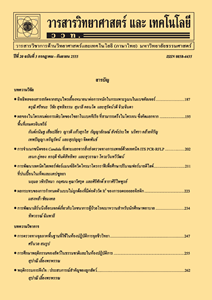สมรรถนะเชิงความร้อนของเครื่องยนต์สเตอร์ลิง-จานรับรังสีแสงอาทิตย์โดยใช้รังสีอาทิตย์เป็นแหล่งความร้อน
Main Article Content
Abstract
This research studied the thermal performance of the solar-Stirling engine using solar radiation as heat source, by developing thermal models of the Stirling engine, and studied the thermal performance of the system by measuring various parameters, i.e. the rate of change in water temperature (dTw) flowing through the heat receiver, absorbed heat value of the calorimeter (Qw), and stagnation temperature (Tps) of the heat receiver. Parabolic dishes are positioned to achieve solar radiation. The heat is focused to the focal point, which places a copper calorimeter as a thermal receiver to find out the absorbed heat input, and then change the heat receiver into a Stirling engine. The engine performance test was carried out, the study indicated that the absorbed energy using copper calorimeter was 178.62 W, heat loss was 2.524 W at a solar radiation intensity of 943 W/m2. The parabolic dish has a thermal efficiency of 47.11 %. The engine's thermal input was 0.982 W, with a heat loss of 0.840 W at a solar radiation of 962.9 W/m2. The temperature difference increases the speed and the thermal performance of the engine. The Stirling engine-Parabolic dish has a thermal efficiency of 0.036 %.
Article Details
References
[2] Kongtragool, B. and Wongwises, S., 2003, A review of solar-powered Stirling engines and low temperature differential Stirling engines, J. Renew. Sustain. Energy Rev. 7: 131-154.
[3] Abbas, M., 2006, Simulation Numérique d’un Cycle de Moteur Stirling Solaire de Type Gamma par la Méthode Découplée. Mémoire de Magister, Université de Blida, Blida.
[4] Ureili, L. and Berchowitz, D.M., 1984, Stirling Cycle Analysis, Adam Hilger, Inc., Bristol, 256 p.
[5] Bonnet, S., 2005, Moteurs Thermiques à Apport de Chaleur Externe: Etude d’un Moteur Stirling et d’un Moteur Ericsson, Ph.D. Thèse, Université de Pau et des Pays de l’Adour, Français, 179 p.
[6] Woodford, C., Stirling Eengines, Available Source: https://www.explainthatstuff.com/how-Stirling-engines-work.html, Septem ber 29, 2018.
[7] Kongtragool, B. and Wongwises, S., 2007, Performance of low-temperature differential Stirling engines, J. Renew. Energy 32: 547-566.
[8] Kongtragool, B. and Wongwises, S., 2008, A four power-pistonlow-temperature differential Stirling engine using simulated solar energy as a heat source, J. Solar Energy 82: 493-500.
[9] Kongtragool, B. and Wongwises, S., 2008, Testing of a low temperature differential Stirling engine powered by using actual solar energy, Int. J. Green Energy 5: 491-507.
[10] Hasnat, A., Ahmed, P., Rahman, M. and Khan, K.A., 2011, Numerical analysis for thermal design of a paraboloidal solar concentrating collector, Int. J. Nat. Sci. 1: 68-74
[11] Çinar, C., Yucesu, S., Topgül, T. and Okur, M., 2005, Beta-type Stirling engine operating at atmospheric pressure, J. Appl. Energy 81: 351-357.


